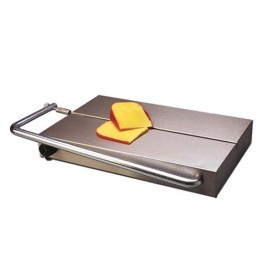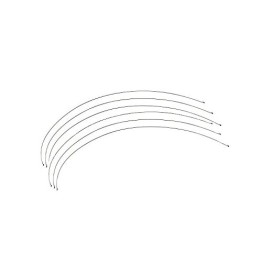Cheese Cutters

Cheese Cutters
Are you a cheese lover who craves the perfect slice every time? Look no further than cheese cutters – the ultimate tool for precision slicing. Whether you're hosting a dinner party or enjoying a simple cheese and crackers snack, a good cheese cutter can make all the difference. But with so many options on the market, how do you choose the one that's right for you?
In this article, we'll dive into the world of cheese cutters and explore the top options available. From wire cutters to rotary slicers, we'll discuss the pros and cons of each type, helping you make an informed decision. We'll also provide tips on how to use a cheese cutter effectively and maintenance advice to ensure your tool lasts for years.
So if you're tired of struggling with uneven slices or cheesy messes, it's time to upgrade your cheese cutting game. Get ready to discover the perfect tool to elevate your cheese experience to the next level. Let's slice our way to cheese perfection!
The Different Types of Cheese Cutters
The world of cheese cutters is rich and varied, offering a multitude of options for cheese aficionados. Each style of cutter is designed with a particular type of cheese in mind, from soft brie to hard Parmesan. The most common types include wire cutters, hand-held slicers, board slicers, and rotary slicers, each with its own unique set of characteristics.Wire cheese cutters are famed for their precision and ease of use. A taut wire, often made of stainless steel, glides through cheese, making clean cuts that are hard to achieve with a knife. They're particularly useful for soft cheeses that might stick to a blade. Additionally, wire cutters are easy to clean and often come with replaceable wires, increasing their longevity.
Hand-held slicers are another popular choice, especially for semi-hard cheeses. These slicers usually have a sturdy handle and a stainless steel blade that can be adjusted for slice thickness. They are portable, simple to use, and perfect for slicing on the go. On the other hand, board slicers, which often feature a built-in wire cutter or blade on a wooden or marble base, offer a stable platform for cutting and are a stylish addition to any cheese board.
Lastly, rotary cheese slicers are an ideal choice for those who want uniform slices of hard cheese. These slicers contain a drum with a blade that turns with the handle, shaving off thin slices of cheese. They are particularly handy for grating cheese over dishes, as they can be used directly at the table.
Benefits of Using a Cheese Cutter
The benefits of using a cheese cutter are manifold, especially for those who take their cheese seriously. Precision is one of the most significant advantages. Cheese cutters are designed to produce evenly sliced pieces, which not only look more appealing but also ensure a consistent taste and texture experience with every bite.Furthermore, using a cheese cutter is more hygienic than using your hands. Cheese is a medium that can easily harbour bacteria, so minimizing contact is crucial for food safety. By using a cheese cutter, you reduce the risk of contamination, keeping your cheese fresher for longer.
Another benefit lies in the efficiency a cheese cutter brings to the table. Whether you're preparing a platter for guests or adding the finishing touch to a dish, a cheese cutter can save you time and effort. Moreover, with the correct cutter, the task of slicing cheese becomes virtually effortless, reducing the risk of mishaps and wasted food.
Factors to Consider When Choosing a Cheese Cutter
When selecting a cheese cutter, several factors must be taken into account to ensure you pick the best tool for your needs. The type of cheese you frequently consume will heavily influence your choice, as different cutters are suited to different textures and hardnesses. For example, a wire cutter is excellent for soft cheeses, while a rotary slicer is better for hard cheeses.Another important consideration is the cutter's material. Stainless steel is the most common and preferred choice due to its durability and resistance to corrosion. It's also easy to clean, which is essential for maintaining hygiene. The cutter's handle should be comfortable to hold and possibly non-slip, ensuring safety and precision in use.
The ease of cleaning is also a factor that can't be ignored. Cheese cutters with fewer crevices and removable parts are generally easier to clean thoroughly. Some models are even dishwasher safe, which is a significant advantage for those who value convenience.
How to Use a Cheese Cutter Effectively
Using a cheese cutter effectively is key to getting the most out of this handy tool. Before you begin, ensure your cheese is at the correct temperature. Some cheeses cut better when cold, while others, like soft cheese, should be closer to room temperature to avoid crumbling.When using a wire cheese cutter, hold the handle firmly and pull the wire through the cheese in one smooth motion. For a cheese board with a built-in wire, you'll typically push the cheese down against the wire, using the base for stability. Always slice at a consistent pace to maintain even slice thickness.
For hand-held slicers and rotary slicers, adjust the blade to your desired thickness before you start. Hold the cheese with one hand and use the other to guide the slicer, applying even pressure. Be mindful of your fingers and keep them clear of the blade as you slice.
Maintenance and Care for Your Cheese Cutter
To prolong the life of your cheese cutter, proper maintenance and care are essential. After each use, clean your cheese cutter thoroughly to remove any cheese residue, which can spoil and affect the taste of future slices. Most cutters are easy to clean with soap and water, although some are dishwasher safe for added convenience.Check your cutter regularly for any signs of wear and tear, especially if it has a wire that may become loose or snap over time. Many wire cutters come with replacement wires, so make sure you have a few on hand. In the case of blades, sharpen them occasionally to maintain their efficiency.
Storage is also important. Keep your cheese cutter in a dry place where it's not at risk of getting damaged. Some cutters come with a protective sheath or case, which is ideal for keeping the blade or wire safe and ensuring the cutter is ready to use whenever you need it.
Popular Brands of Cheese Cutters
When it comes to cheese cutters, several brands stand out for their quality and reliability. Prodyne is well-known for its wire cheese cutters with durable cutting wires and stylish designs. Their cutters often feature a marble base, which not only looks elegant but also keeps cheese cool.Boska Holland offers a range of cheese cutters that cater to both casual cheese lovers and professional fromagers. From their Taste Collection to their Professional Series, Boska Holland cutters are innovative and built to last.
Another reputable brand is OXO, which provides ergonomic cheese slicers with adjustable wires and comfortable handles. Their commitment to user-friendly design makes their cutters a favourite among those who value ease of use.
Where to Buy Cheese Cutters
Cheese cutters can be found in a variety of places, from kitchenware shops to online retailers. Specialty cheese shops often carry a selection of high-quality cutters, and they can provide expert advice on which type to choose based on your cheese preferences.Online marketplaces like Amazon and eBay offer a wide range of cheese cutters, with the convenience of reading customer reviews before making a purchase. You can also check out the websites of popular brands for their latest products and deals.
If you prefer a hands-on shopping experience, department stores and home goods stores typically stock a variety of cheese cutters. Here, you can handle the tools and perhaps even see a demonstration to help you make your decision.
Cheese Cutting Techniques and Tips
To master cheese cutting, a few techniques and tips can go a long way. Always cut cheese from the centre outwards, which helps maintain the structure of the cheese and presents well on a board. For block cheeses, slice them thinly to maximise flavour and texture.For soft cheeses, chilling them slightly can make them easier to cut. However, remember to let them come to room temperature before serving to ensure the best flavour. When cutting crumbly cheeses, use a gentle sawing motion and don't apply too much pressure.
A final tip is to match the size of your cheese slices to the occasion. Thinner slices are typically better for taste-testing and pairings, while thicker slices may be more suitable for sandwiches or cooking.
Conclusion
Choosing the right cheese cutter can significantly enhance your cheese experience, whether you're a connoisseur or a casual snacker. By understanding the different types available, recognising their benefits, and considering the essential factors, you can select a cutter that meets your needs. Remember to use it effectively, maintain it well, and explore various cutting techniques to get the most out of your cheese. With the right tool in hand, you're all set to enjoy your cheese at its best – perfectly sliced and wonderfully presented.Cheese Cutter Manual- Anvil - 400mm
Cheese Cutter Manual- Anvil - 400Mm. For Use In Anu Deli And Supermarket Cheese Division...
R1,845.00 R2,460.00 Ex Tax: R1,845.00
Cheese Cutter Replacement Wire - Pack Of 6.
Cheese Cutter Replacement Wire - Pack Of 6....
R0.00 Ex Tax: R0.00
Showing 1 to 2 of 2 (1 Pages)


